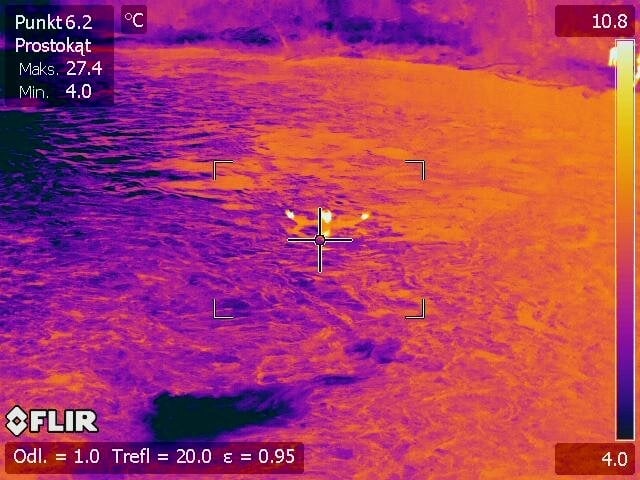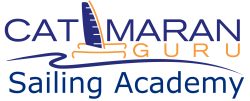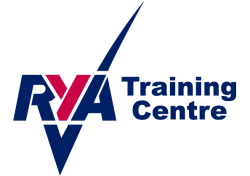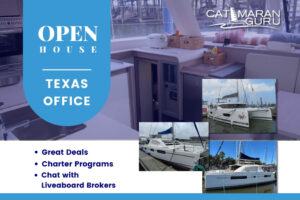Delayed reactions, lack of understanding how to operate MOB recovery technology, and other challenges to success recovery of a crewmember are best overcome with frequent practice and discussion of the MOB procedures with the crew. After all, when crew falls off the deck, it is rarely a good time for it as often you are in turbulent conditions with limited visibility and our attention is on important tasks at hand just sailing.
Turning your catamaran around to head back in the right direction is not as easy as it might seem, especially at night.
In this article we discuss technologies and techniques that can increase MOB survival aboard your boat. And we offer these resources for additional reading:
- Learn and practice the “crash stop” MOB recovery method.
- For inspiration to increase the frequency of MOB discussions and training aboard your vessel, read some MOB stories.
- Keep reading about ways to avoid fatal MOB situations.
- One of our favorite MOB lifesaver devices.
Developing MOB “Instinct”
Captains and crew need to be prepared with knowledge and skills to use all MOB devices on board immediately. MOB drills, performed often, are the best way to prepare your crew to deploy electronic and mechanic tools quickly and correctly to enhance the chances of a successful reunion aboard.
Drills help your crew develop the right “knee jerk” reactions to a MOB situation. Learning and acting with the correct first actions to an emergency like MOB is essential not only to a good outcome, but also to reduce chaos. If a crewmember has developed the skills to immediately take action, there is no time in their brain for chaos, at least in the critical first moments. Taking the initial actions quickly and properly gives captain and crewmembers time to then support each other as they move through the next steps of recovery. For example, most GPS chart plotters have a MOB feature to enable a crewmember to fix a position on the GPS screen at the point where someone went into the water.
Even a seasoned sailor needs to experience MOB drills as the MOB skills and actions needed are different based on boat model and MOB equipment aboard. It is best to practice in a variety of conditions considering the number of crewmembers and their experience, boat speed, time of day, visibility, wind, and sea conditions.
The Royal Yachting Association (RYA) though a proponent for MOB procedure preparedness, does not specify one method because there are so many variables at play to determine what is right for your boat and crew. But, establishing “first actions” for your situation and practicing them is vital. Keep in mind that the “first actions” you adopt may change over time as the equipment, crew, and point of sail change.
For any scenarios that you have not practiced, for example, MOB at night or heavy seas, talking through these situations and what would feel different and any additional steps needed is better than not addressing them at all.
Most GPS chart plotters have a MOB feature that allows you to fix a position on the GPS screen at the point where someone goes overboard. That’s very useful information, but it makes a dangerous assumption that someone knows a crew mate has fallen overboard.
Special Considerations for MOB at Night
Recovery of a crewmember in the dark carries higher risks than daytime no matter the wind, sea, or other conditions. Technology can be used to improve your odds. One if the best tools is an AIS personal locator beam (PLB), sometimes referred to as personal EPIRBs (Emergency Position Indicating Radio Beacons) since their function is the same as their larger EPIRB cousin used to locate boats in distress.
These AIS PLBs combine highly useful technologies:
- AIS – use standard VHF radio to broadcast a standard MOB alarm and position information to vessels in the area (usually to the horizon line). You may be familiar with AIS (Automatic Identification System) as it was originally developed as a collision avoidance system. Commercial and recreational boats of all sizes use AIS to send and receive data including position, heading and speed. This information shows up on the vessels chart plotter, allowing captain and crew to easily identify and visualize marine traffic around them.
- PLB – broadcast their signal on the COSPAS-SARSAT System to alert rescue authorities that a person is in the water just like an EPIRB does for boats in distress. But a PLB is registered to an individual instead of a boat, though the vessel name is required. This means if you change boats, you need to update your PLB registration.
AIS PLB exponentially ups the chances of recovery of a crewmember overboard.
Personal MOB Beacons
These devices use radio frequencies to activate equipment on the boat that alerts crew that someone is separated from the boat. PLB fall into two categories: those with AIS and those with an electronic tether between a base station and individual monitors.
Personal AIS MOB Beacons
Personal AIS beacons are worn on an inflatable personal flotation device (PFD). When the PFD inflates, the unit extends an antenna that begins broadcasting a unique MOB identifier on the AIS system. This signal causes any vessels within a 3-5 mile radius equipped with an AIS receiver to be alerted to a MOB situation with an audible alarm. This lets the boat the person fell from as well as other boats in the area that a situation requiring assistance is in progress. This, of course, greatly improves the speed of a rescue as well as accurate location of the person in the water.
Some personal AIS beacons also broadcast an alert on the VHF DSC (digital select calling) system. This feature can increase the number of boats alerted as if a boat in the area does not have an AIS receiver, but is listening to a VHF radio, an alert with lat/long from a built-in GPS broadcasts will be received with the DSC signal.
Tethered MOB Devices
Not all boats are equipped with or need to be equipped with an AIS receiver. So another type of MOB unit is based on using an electronic tether. They come with a variety of features. Some tethered MOB devices use a smart mobile device (phone or tablet) app that detects a low-energy Bluetooth link to monitor MOB devices on individual crewmembers. If one of the devices is submerged or loses contact with the mobile app, it sounds a MOB alarm. The app uses the mobile device’s internal GPS to guide the crew aboard to return to the point of separation.
It is important to realize that the tethered MOB app does not locate an individual unit using Bluetooth. The app simply uses the smart mobile device’s GPS and compass to identify the point where the person or pet or other asset such as a towed dinghy became separated from the vessel.
Of course, in order for these personal MOB devices to work, they must be worn so it is imperative that all crewmembers wear their PFD went on the exterior decks.
Another Effective Low-Tech Option
In addition to using AIS PLB, use ultra-bright LED flares to make the person in the water more noticeable in some conditions. The beams emit light for 5-6 hours and can be switched on and of.
Another technique that is worth exploring especially in higher risk passages like ocean crossings is the use of infrared cameras.
These cameras “see” heat producing a thermal image which can significantly increase the chances of spotting your floating crewmember at night.

Technology Saving Lives
The outcomes of MOB situations are much better with the use of technology available. And these technologies become easier and easier to use. From wearable transmitters that automatically alarm when a crewmember is out of range to PLBs.
In today’s world of wearable tech, the time to alert a MOB can be significantly reduced. For example, now a crewmember does not have to access the chartplotter to activate the MOB button, they can do so on their smart watch.
Your Responsibility for Yourself as Crewmember
To increase your chances of surviving being swept overboard, understand how to activate your PLB or AIS transmitter. Whether yours activates with your lifejacket or is in your pocket, having it immediately on is imperative. Note that if you tend to not wear a lifejacket when sailing warmer waters, keeping your locator in your pocket is the better idea.
Though your captain should initiate discussions, training, and drills, no matter your role aboard, ultimately, you want to ensure that your fellow crewmembers are prepared to save you with the added bonus that they will also be better prepared to save themselves. Ensure before setting sail that everyone knows:
- How to use the VHF radio to get help.
- How to push the distress button to send details of your vessel identity and position.
- To be aware that follow up with sending the distress signal due to the many false alarms that happen. Without signaling again or following up with a voice message may result in the alarm being ignored by the Coast Guard.
Summary MOB “First Actions” for the Crew
- Call out ‘Man Overboard’ to alert the entire crew
- Drop a lifebuoy, danbuoy, or jonbuoy.
- Assign a crewmember to point at MOB so crew at the helm can easily visually locate them.
- Press the MOB distress button on chartplotter or smart watch
- By day, deploy an orange smoke canister. At night, throw a floating torch.
- Start recovery maneuver.
Have More Questions? Want to Schedule MOB Training? Contact Us!
Sail With Us to Learn


Week-Long Liveaboard Courses
Rare RYA Classes & Certifications
Catamaran Guru’s real-life practical methods combined with up-to-date sailing theory in lessons aboard recent model catamarans…or your own boat!
Prepare for certifications or take the first step aboard to embark on your dream life of boat ownership or cruising
Classes in S Florida and the Bahamas.






